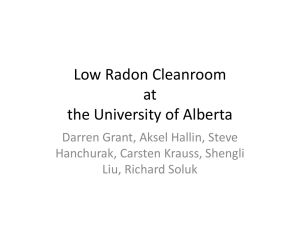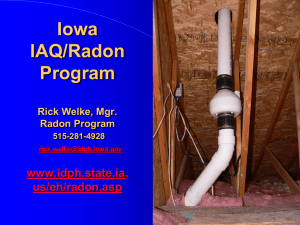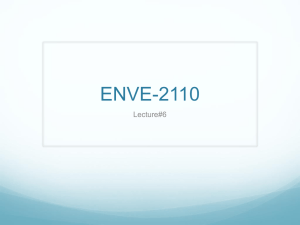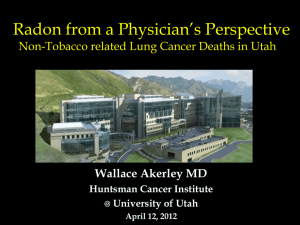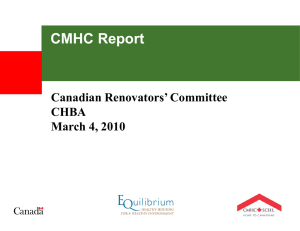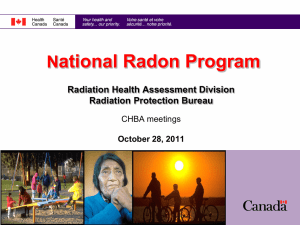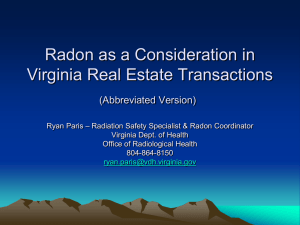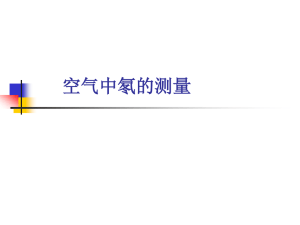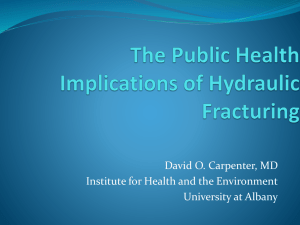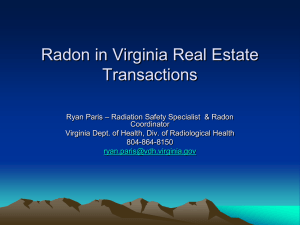Link to Slides
advertisement
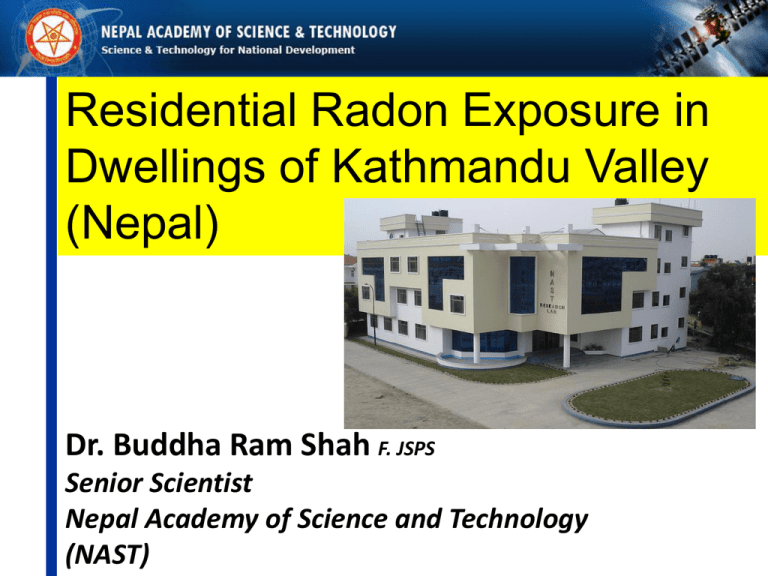
Residential Radon Exposure in Dwellings of Kathmandu Valley (Nepal) Dr. Buddha Ram Shah F. JSPS Senior Scientist Nepal Academy of Science and Technology (NAST) Brief Introduction of NAST & Activities Radon Monitoring Program Nepal Academy of Science and Technology (NAST) Establishment Established by a Royal Ordinance as an autonomous apex body in December 5, 1982 Promulgation of RONAST Act by the Parliament of Nepal in 1991 NAST Act revisions by the Parliament of Nepal in 2007 Introduction RADON ????? Radon is a colorless, odorless, tasteless, naturally occurring radioactive gas produced from the decay of the element radium, which occurs naturally in rocks and soil worldwide….. 2nd leading cause of Lung Cancer after smoking... Production of Radon and its daughters from Uranium decay. U238 Ra226 (1600 yr) Rn-222 (3.8day s) Pu-218 (3.05m ) Pb-214 (26.8m ) Po-210 (138.4 days) Pb-206 Stable Bi-210 (5.01d ay) Bi-214 (26.8m ) Po214 (164µ s) Short lived pollutants Pb210 (21yr) Long Lived Pollutants Radon entry inside the dwelling: Damage of DNA due to Ionizing Alpha particle: Alpha Particle Defects in tumor suppressor genes – p53 Objective: To evaluate the Radon activity concentration in (Bq/m3) over the exposure time of 100 days. To determine the annual effective dose from Radon in (mSv/yr). To evaluate the concentration of radon progeny in terms of Potential Alpha Energy Concentration (PAEC) in (mWL). To determine the life time fatality risk due to radon. Materials and Methods: Material: Kodalpha Radon Dosimeter developed by KODAK company, France Type: Type II, LR115 film plastic track detector Dimensions: 4.0cm×7.5cm×0.5 cm Composition of LR115 film: 12µm thin film of red coloured Cellulose nitrate coated in 100µm thick polyester base. SSNTD Track Analysis: Etching LR115 Film Ionization Under Optical Microscope (300X) Etching: 2.5 M NaOH, 60 0C for one and half hour Swift moving αparticle alpha tracks Experimental Details: Altogether 41 numbers of dwellings around Kathmandu Valley, were selected. Two rooms including kitchen and bedroom were selected in each house. Houses were concrete with plastered walls and proper ventilation system. Dosimeters were installed at the height of 2m from the floor for 100 days. Radon Dosimeter hanged on the wall. Working formula: Calibration Factor: As determined by Dosirad Laboratory France, the calibration factor of our dosimeter was 2.1 tracks/cm2 = 1 kBqh/m3 Result and Discussions: Table shows Average radon concentration, annual exposure, annual effective dose and life-time fatality risk of Kathmandu Valley. S.N. Name of district Total number of Dwellings Radon Concentration in Annual (Bq/m3) Effective dose in (mSv) Minimum Maximum Average±2σ 1. Bhaktapur 12 36±8 415±71 90±17 1.54 2. Kathmandu 20 8±2 161±29 56±11 0.96 3. Lalitpur 9 8±2 787±134 93±17 1.59 80±15 1.36 Arithmetic mean 350 300 250 200 150 100 50 0 Su rya bin ay ak Lu ka Ga ntha tht l ha i g Du har wa k Du ot 1 wa ko Jh t 2 au kh el Sa lla gh Ch ari un d Du evi dh pa ti Ka T ma him i lbi na ya k Bo de Average Radon Concentration (CRn) 400 CRn in Bedroom CRn in Kitchen Name of place Average radon concentration in bedroom and kitchen of different dwellings of Bhaktapur district: an th Ba a Ki laju rti Ki pur rti 1 pu r2 N Sh an axal tin ag Te ar ku 1 Mi Teku n Ma bha 2 ha wan r Ba ajgu n n Gu eshw j rju or So dhar rak a Ha hut ttig te au Jo da rp Dh ati a Ma pasi Sin itide v a An mang i am al na Ka gar lan ki Bu da nil k Average Radon Concentration (CRn) Average radon concentration in bedroom and kitchen of different dwellings of Kathmandu district: 160 140 CRn in Bedroom CRn in Kitchen 120 100 80 60 40 20 0 Name of place Average radon concentration in bedroom and kitchen of different dwellings of Lalitpur district: 700 CRn in Bedroom CRn in Kitchen 600 500 400 300 200 100 0 Dh ap aH eig Go ht da m Ch au r Kh um alt ar Ha ttib Ma an ng al Ba zar Gw ark o Dh ob igh at La ga nk he l Sa tdo ba to Average Radon concentration (CRn) 800 Name of Place Conclusion: The measurements indicate higher radon concentration in industrially polluted and densely urbanized areas like Kamalbinayak, Kirtipur, Maharajgunj, Sinamangal and Godam Chaur of Kathmandu valley. We found the radon concentration is maximum in kitchen than in bedroom in most of the dwellings due to extra contribution of radon from water and cooking gas, kerosene, etc. The low radon level in most of the concrete houses with plastered walls is due to the proper ventilation system. Also the cement impedes the flow of radon as it has low permeability. Although, the overall concentration of radon and annual effective dose of radon and its progeny in Kathmandu valley are well within the action level (200-600 Bq/m3 and 3-10 mSvy-1) of International Commission of Radiological Protection (ICRP-103, 2007) , one of the places that is Godam Chaur area of Lalitpur district is under the significant radiological threat to the population. Radon Awareness Program Program in Pokhara- Amar Singh HSS wGojfb . Thank You!

